
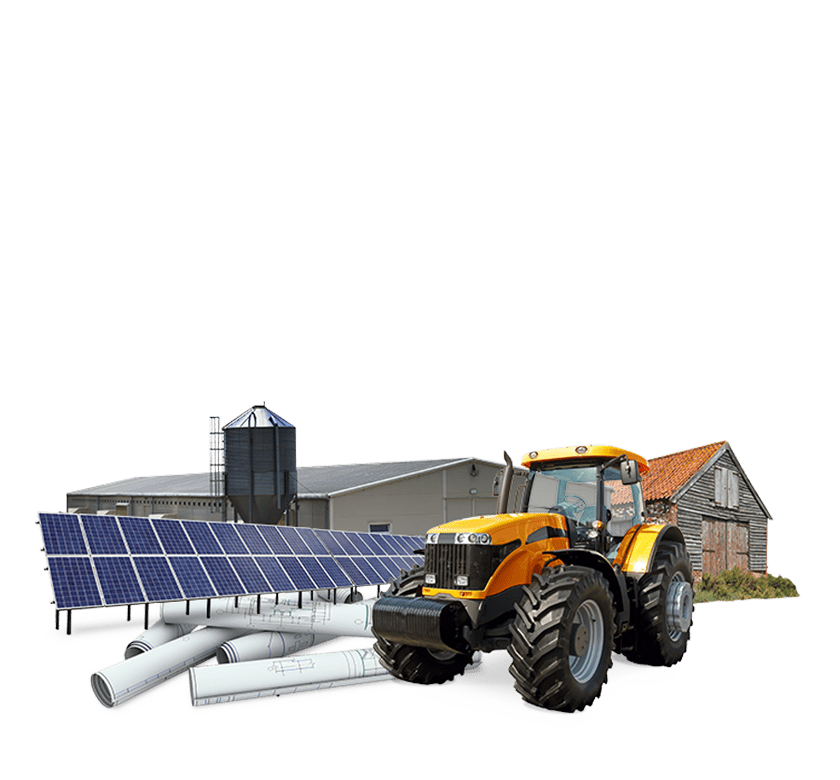
Agricultural & Farm Finance
Farm finance is a specifically designed range of financial products for agricultural businesses, including bridging loans, development finance, asset finance, and commercial mortgages.
We arrange finance for farms and agricultural businesses, including traditional farms (Arable, Livestock or mixed) and diversified agricultural businesses (Renewable Energy Production, Agritourism, Farmers' Markets and Farm Shops, Agroforestry, Eco-services, Event companies or Land Leasing). Our farm finance facilities span £50k to £250m.
Farm finance has multi-purpose uses, including land loans and commercial property finance for purchases, development and renovation, such as property conversion finance, revenue diversification, crop/livestock/plant/machinery investment such as tractor finance, generational transfers, tax payments or cashing out equity for working capital.
Whether you need property development finance to convert barns or agricultural buildings into residential, purchase more poultry dairy equipment or want to diversify into a solar farm, geothermal plant or other renewable energy production, our finance, secured on agricultural or residential property and land is available to any credible business proposal with a viable exit strategy.
We offer experience-based, impartial information, sourcing finance from specialist UK-based lenders to ensure your rates are as low as possible for your specific circumstance.
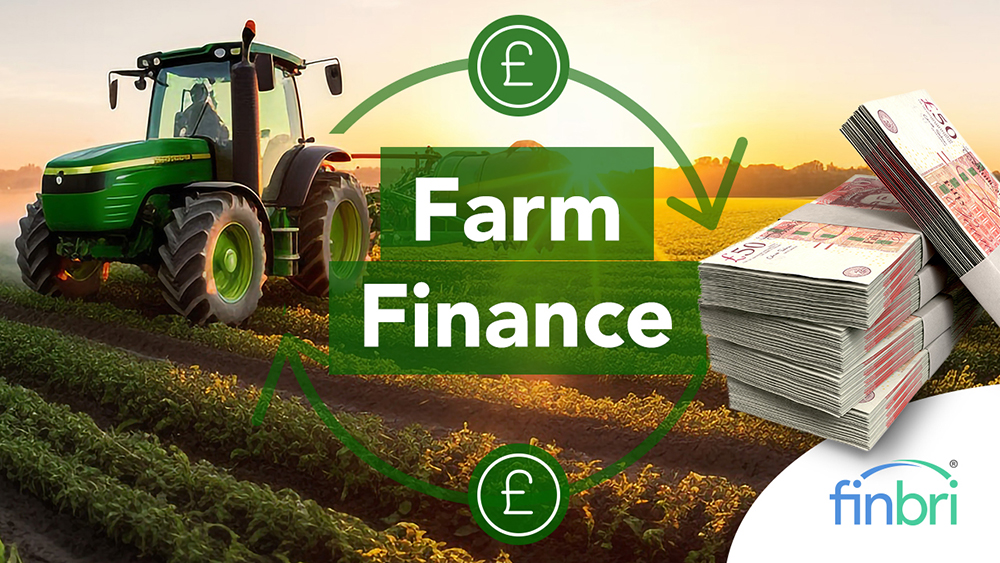
Our Farm Finance service
- Market-leading property farm finance from £50,000 to £250m
- Monthly interest rates from 0.75% pm
(Lower rates for £700,000+ loans or less than 50% LTV) - LTVs up to 70% (up to 100% finance if additional collateral is available)
- No monthly payments with interest rolled-up options
- Terms up to 24 months
What is farm financing used for?
Our farm finance and agricultural loans are used for:
- Class Q Property Development Projects
- Residential and Agricultural Property Refurbishment
- Residential and Agricultural Property Purchases
- Refinancing existing borrowing
- Land Purchase
- Livestock Purchase
- Recovery & Restructure
- Renewable Energy Development
- Diversification
- Generational Transfers
- Settle Time Sensitive Tax Payments
- Working Capital & Cash Flow.
Commercial ventures always come with uncertainty, but thriving in the farming and agricultural sectors is tough. Property maintenance, mechanical breakdowns, unseasonal weather, livestock issues and rapidly changing circumstances throughout the food supply chain are common day-to-day battles.
Even farmers and landowners primarily focused on agriculture are now justifiably seeking to diversify their revenue sources through investing in renewable energy, change of use, property development or leisure and hospitality opportunities.
Short-term financing makes or breaks businesses in the sector. From farming, agriculture, and equestrian to horticultural, many businesses' success hinges on fast access to funds to help sustain or radically evolve their business model.
Farm Finance Lending Criteria
| Loan to value (LTV) | 70% maximum |
| Loan term | 3 to 24 months |
| Loan amount | £50,000 up to £250m |
| Interest options | Rolled-up, retained or serviced |
| Interest rates | From 0.75% |
| Decision | Immediate decision in principle |
| Completion |
Up to £300k in 3 days |
| Early repayment fees | None |
| Availability | Secured on assets in the UK & Europe Individuals, Companies, SPVs No credit & adverse credit considered |
| Exit strategy | Sale or refinance |
2024 Farm Finance Guide
Farm finance in the UK encompasses a broad spectrum of financial products designed to meet the unique needs of the agricultural sector.
From acquiring assets and expanding operations to diversification and sustainability initiatives, farm finance is pivotal in helping farmers and agricultural businesses thrive. This guide aims to unravel the complexities of farm finance, offering clarity on how it is used to enhance revenue, alongside step-by-step processes for securing various types of farm financing.
Contents
What is Farm Finance?
Farm finance in the UK is a form of financing specifically tailored to the needs of UK farmers and agricultural businesses.
It covers various agricultural needs, from buying land and buildings to purchasing livestock or farming equipment and farm diversification. Farm finance provides farmers with the capital and funds they need to maintain their operations or help them grow and expand their businesses.
This guide will explain what farm finance is and its benefits and offer examples of how farmers in the UK use it to boost their revenue.
Common questions about Farm Finance
Understanding farm finance is crucial for both new and established farmers. Managing finances effectively not only ensures the sustainability of farm operations but also maximises profitability.
Key financial questions and challenges facing UK farmers today, providing insights and solutions to help you navigate the complexities of farm finance.
Securing Farm Financing
Accessing funds is a fundamental concern for farmers whether starting, maintaining or expanding their operations. In the UK, traditional financing options, including bank loans, government-backed loans, and grants, are frustratingly slow and bureaucratic. Unhelpful for farmers. Thankfully, alternative financial products such as asset finance, bridging finance and property development finance are quicker and have less red tape. There's a step-by-step guide to securing each of the common forms of farm finance a bit further on this page.
Enhancing Farm Profitability
Improving your farm's profitability will involve several strategies, including diversification (e.g., agritourism, renewable energy production), cost reduction, and adopting precision farming techniques. Developing value-added products also increases revenue. Regularly reviewing and adjusting your business model in response to market demands and technological advancements will increase efficiency and profitability.
Farm Budgeting and Financial Planning
Effective financial management starts with good budgeting and solid planning. Utilise software tools designed for farm management to track income, expenses, and cash flow. Annual financial planning should account for fixed costs (e.g., finance payments) and variable costs (e.g., seed, fertilizer). Setting aside funds for unexpected expenses will help mitigate financial risks associated with farming.
Managing Farm Debt
Strategic debt management is essential for maintaining financial health. Consolidating loans or refinancing to secure lower interest rates reduces repayment burdens. Engage with financial advisors or agricultural finance specialists to explore the best options for your situation, and always ensure that debt levels are sustainable relative to your farm’s income potential.
Tax Considerations
Agricultural tax planning involving VAT, inheritance tax, and capital gains tax is complex. Utilise the expertise of accountants specialising in agricultural businesses to take advantage of available tax reliefs and efficiently structure your business for tax purposes.
Assessing Financial Health
Key performance indicators (KPIs) such as return on investment (ROI), profit margins, and debt-to-income ratios are valuable for assessing your farm's financial health. Regular analysis of these indicators inform decision-making and highlight areas for improvement.
Insurance for Farm Operations
Adequate insurance coverage is vital for protecting against the financial impact of unpredictable events. Essential policies include crop and livestock, property, and liability insurance. Tailor your insurance coverage to the specific risks associated with your farming activities.
Succession and Retirement Planning
Planning for the future of your farm involves considering succession planning (whether passing it on to kin or through management buy-outs) and retirement. Early planning ensures a smooth transition, safeguarding the farm's legacy and your financial security in retirement.
Managing Input Costs
Keeping input costs under control is vital for maintaining profitability. Consider bulk purchasing, cooperative buying groups, or forward contracts to lock prices for seeds, feed, and fertilisers.
Leasing vs. Buying Equipment, Machinery or Plant
Leasing or buying depends on your farm’s cash flow, tax considerations, and the equipment's expected lifespan. Asset Leasing (Asset Finance) offers flexibility and lower upfront costs, while buying is more cost-effective in the long term.
Risk Management
Diversifying income streams, utilising futures contracts for price stability, and adopting sustainable farming practices help manage the risks inherent in agriculture.
Financing for Sustainable Practices
For those interested in sustainable or organic farming, specific grants and loan programs support environmentally friendly practices. DEFRA and other organisations dedicated to sustainable agriculture provide research opportunities.
The Application Process
Applying for a small bridging loan or any agricultural financing typically involves submitting an application, undergoing a valuation, and passing underwriting processes. Preparation, clear financial records, and a robust business plan streamlines approval.
Securing Farm Financing
Unfettered access to funds is a fundamental requirement for most farmers starting, maintaining or expanding their operations.
In the UK, farm financing options include:
- Asset finance is suitable for accessing equipment, machinery, and plant via leasing or finance. Options include leaseback, lease to own, operating lease, and contract hire.
- Bridging finance is suitable for raising non-status high-value loans quickly to bridge a short-term financial need for almost any purpose.
- Property development finance is suitable for raising property development, conversion, and renovation funds.
- Traditional bank loans are most suitable for raising finance with an established successful business.
- Government-backed loans
- Grants through the Rural Payments Agency (RPA) and the Rural Development Programme for England (RDPE).
Whether you're looking to invest in new equipment, bridge a gap in funding, develop property, or sustain your farming operations, understanding how to secure the right type of finance is crucial. Below, we detail the steps in securing various types of farm finance, from asset finance and bridging finance to government-backed loans and grants.
Asset Finance
Step 1: Assess Your Needs
Identify the assets you need to finance, whether machinery, vehicles, or equipment, and how they will contribute to your farm's operations.
Step 2: Research Potential Lenders
Contact our experts for access to the whole market, or look for lenders specialising in agricultural asset finance. Compare terms, interest rates, and repayment schedules.
Step 3: Prepare Financial Documentation
Gather your financial records, including balance sheets, cash flow statements, and tax returns, to demonstrate your farm's financial health.
Step 4: Apply
Submit your application, the required financial documentation, and details about the assets you wish to finance.
Step 5: Negotiate Terms
Once approved, negotiate the terms of the finance agreement to ensure they meet your needs and repayment capacity.
Step 6: FinaliSe the Agreement
Review the finance agreement carefully before signing. Ensure you understand all the terms and conditions.
Bridging Finance
Step 1: Identify the Funding Gap
Determine why you need bridging finance and the amount required to cover your short-term funding gap.
Step 2: Find a Lender
Contact our experts for your fast, best-rate, no-obligation quote or search for lenders offering bridging finance to the agricultural sector. Consider interest rates and loan terms.
Step 3: Prepare Your Proposal
Include details of why you need the loan, how you plan to use the funds, and your exit strategy for repaying the loan.
Step 4: Apply and Provide Security Details
Apply for the loan and provide information on the security you offer against the loan, such as property or land.
Step 5: Review the Offer
Once approved, carefully review the loan offer, paying close attention to the interest rate, fees, and repayment terms.
Step 6: Complete the Loan
Accept the offer and complete any final documentation. Ensure you adhere to the repayment schedule as agreed.
Property Development Finance
Step 1: Project Plan
Outline your property development project, including costs, timelines, and expected returns.
Step 2: Research Lenders
Identify lenders offering property development finance experience with agricultural sector experience, or contact us for a free no-obligation appraisal.
Step 3: Prepare a Detailed Application
Include your business plan, financial projections, and details about the development project.
Step 4: Submit Application
Present your application to the chosen lender along with any requested supporting documentation.
Step 5: Agree on Terms
Discuss the finance terms, including interest rates, drawdowns, and repayment plans.
Step 6: Legal and Valuation Checks
Undergo any necessary legal checks and property valuations as required by the lender.
Step 7: Access Funds
Access the funds to commence your development project upon approval and completion of all checks.
Traditional Bank Loans
Step 1: Business Case
Prepare a solid business case for the loan, detailing how it will be used and the financial benefits for your farm.
Step 2: Choose a Bank
Select a bank with strong agricultural lending experience. Review their loan products to find one that suits your needs.
Step 3: Application
Complete the loan application, providing detailed financial information and business plans.
Step 4: Negotiation
Discuss the loan terms, including interest rates, repayment schedules, and any security required.
Step 5: Approval and Funding
Once approved, sign the loan agreement and receive the funds for use as planned.
Government-backed Loans
Step 1: Eligibility
Check your eligibility for government-backed loan schemes aimed at farmers and the agricultural sector.
Step 2: Application Requirements
Gather all necessary documentation, including business plans and financial statements, as the loan scheme specifies.
Step 3: Apply
Submit your application through the designated government portal or office.
Step 4: Compliance
Ensure your farm complies with any required standards or conditions the government loan scheme sets.
Step 5: Receive Funds
Upon approval, comply with any final requirements to receive the loan funds.
Grants through RPA and RDPE
Step 1: Grant Opportunities
Identify available grants through the RPA and RDPE that align with your farm’s needs and projects.
Step 2: Understand Criteria
Carefully review the eligibility criteria, application deadlines, and project requirements for the grant.
Step 3: Prepare Your Application
Develop a comprehensive application that outlines your project's objectives, benefits, and budget.
Step 4: Submit Application
Apply within the stipulated timeframe, ensuring all required documentation is included.
Step 5: Monitor and Report
If awarded a grant, adhere to any monitoring and reporting requirements set by the RPA or RDPE.
Each type of farm finance has its own set of steps tailored to its specific requirements and processes. Following these guidelines effectively navigates the finance application process and secures the necessary funds to support and grow UK farmers' operations.
Farm Finance uses
Farm finance helps agricultural businesses in five very different ways.
- Helping acquire equipment, machinery and plant
- Helping purchase land, livestock, seed and grain
- Helping finance property development
- Helping fund the diversification of innovative revenue streams
- Helping fund working capital with short-term finance.
Acquiring farm equipment, machinery and plant
Farm finance, such as tractor finance, helps you purchase different types of farm equipment, machinery and plant, including:
- Tractors
- Telehandlers
- Combine Harvesters
- Ploughs
- Balers
- Dairy Equipment
- Poultry Equipment
- Biomass Boilers
- Agricultural Robots.
Affording new equipment and plant without financial help is difficult for farming businesses because farming machinery is expensive. Farmers can acquire what their business needs with farm finance in either Asset Finance or Bridging Finance.
Purchasing different types of farm stock and materials
Farm finance is also used to purchase materials and supplies for the farm. Seeds, fertiliser, livestock feed, and other supplies are necessary for any expensive farming operation. Farm financing allows farmers to buy the necessary supplies without tapping into their cash reserves.
Farm diversification
Farm diversification is branching out into new activities and areas that offer additional income streams and help reduce the risk of relying solely on crops and livestock.
Asset finance could help fund:
- Solar panels, wind turbines, or biomass energy plants
- Energy battery storage and infrastructure
- HVAC, Kitchen appliances and catering equipment for Farm Shops & Cafés
- Leisure vehicles and trailers for farm tours and agritourism.
Development finance could help fund:
- Land and Property purchases
- Property conversion and renovation
- Ground-up development
- Class Q Property Development Projects
Bridging finance could help fund:
- Working capital
- Urgent bills or arrears
- Property refurbishment
- Generational transfers
By diversifying farm activities, farmers increase their revenue by utilising different areas of expertise to make the most of their resources.
Benefits of farm diversification
Farm diversification has a range of potential benefits, both financial and otherwise.
Diversification helps to stabilise cash flow, reducing the reliance on monthly payments from government schemes and higher prices for produce by increasing the amount of revenue generated from different sources.
Diversification also increases the yield from otherwise “idle” areas of the farm, such as arable land only used during the agricultural season. The farm's long-term viability is helped by providing a more varied and dependable income source and allowing the farm to adapt to changes in the industry.
Examples of farm diversification
Farms that diversify their revenue streams beyond traditional farming practices use farm finance in several innovative ways.
Common alternative sources of income for farms that can be financed include agritourism, leisure and hospitality, children's activity centres, renewable energy production, leasing land, value-added products, workshops and educational programs, farmers' markets and farm shops, microbreweries and distilleries, garden centres, agroforestry and forestry products, eco-services, boarding services, subscription boxes and CSA programs, digital products and consulting services. There are many opportunities to diversify.
Agritourism
Agritourism includes farm tours, corn mazes, petting zoos, pick-your-own fruits or vegetables, farm stays, and educational workshops. Agritourism attracts visitors to the farm, generating additional income and raising awareness of farming practices.
Leisure Parks & Holiday Lets
Many UK farmers are diversifying their land use and capitalising on holiday tourism. This includes using property development finance to convert agricultural buildings into holiday lets or a bridging loan to convert barns into lodges.
Equestrian Centres
An equestrian centre generates revenue from the sale and hire of horses and provides space for additional activities such as riding lessons, shows, and events.
Children Activity Centres
Children's activity centres provide a fun and safe place to enjoy while generating income from parties, events and activities. These examples, and many more, are ways of using farm finance to diversify and increase the farm’s revenue streams.
How farm finance is used to maximise profits is vast and varied. By focusing on diversification, farmers can reduce their reliance on traditional sources of income, improving overall profitability and helping to ensure the long-term sustainability of their farms.
Renewable Energy Production
Farms generate income by installing renewable energy sources like solar panels, wind turbines, or biomass energy plants. These generate large amounts of clean, renewable energy for farms. The energy produced is used on the farm or sold back to the grid. This creates a significant additional source of income and improves the farm's overall profitability, as electricity costs are greatly reduced.
Value-Added Products
Creating products such as jams, cheeses, cured meats, or baked goods from farm produce adds value and opens new markets. Organic or speciality products command a higher price.
Leasing Land for Events
Farms that host events like weddings, corporate retreats, and festivals provide a unique venue that can command premium pricing.
Workshops and Educational Programs
Offering sustainable living, gardening, cheese-making, canning, foraging, or craft classes attract people interested in learning new skills - a growth area.
Farmers' Markets and Farm Shops
Selling directly to consumers through farmers' markets or an on-site farm shop yields higher profit margins than wholesale distribution.
Microbreweries and distilleries
Diversifying into micro brewing and selling beer on an artisan scale is hard work involving long hours and, if a brew fails, heavy disappointment only rewarding you with up to 15% profit margins at best.
Garden Centres
Similar to Farm shops, diversifying as a garden centre generates a much-needed boost in revenue. Garden centre's revenue-generating opportunities include fruit picking, nurseries, tea rooms and gift shops.
Agroforestry and Forest Products
Integrating trees and shrubs into agricultural landscapes (agroforestry) produces timber, nuts, and fruits. Non-timber forest products like mushrooms, honey, and medicinal herbs.
Eco-services
Farms participate in carbon credit markets or conservation programs, getting paid to implement practices that sequester carbon, protect water quality, or preserve wildlife habitats.
Boarding Services
For farms with adequate facilities, offering boarding services for horses or other animals, such as dog kennels, are a steady source of income.
Subscription Boxes and CSA Programs
Community Supported Agriculture (CSA) or subscription box services offer consumers regular deliveries of farm produce, providing farms with a predictable income stream.
Digital Products
Farms that sell digital products such as ebooks, online courses, webinars on farming techniques, DIY projects, or cooking classes open up a new internet-based revenue stream.
Consulting Services
Experienced farmers who offer consulting services to new farmers or those looking to implement sustainable practices leverage their expertise for additional income.
By diversifying their income sources, farms become more financially stable, reduce reliance on traditional crop or livestock markets, and increase sustainability.
Farm finance for property development
Farm property development finance is used for various development projects and purposes, including light or heavy property refurbishment, barn conversions, agricultural building conversions and ground-up development for residential use such as homes or holiday lets.
We help arrange the Farm finance to capitalise on your existing assets and the inherent potential value of rural land.
Property Refurbishment & Barn Conversions
The construction sector has seen a surge in demand for rural property over the past decade from those looking to escape to the country.
This demand has created an opportunity for farmers to capitalise on their land by refinancing existing assets or using farm finance to refurbish and upgrade existing buildings, such as barns or agricultural buildings, for use as residential and holiday lets or leisure and hospitality projects. Property conversion projects have been further boosted by a relaxation of planning regulations with what's known as 'Class Q planning'.
Farm finance is used to finance the cost of converting barns or other existing buildings into habitable properties. This can include everything from improvements to insulation and roofing to installing amenities.
Refurbishment projects are especially financial lucrative for farms, as they can increase the capital value of the land whilst also providing an additional revenue stream for the farm. Furthermore, the agricultural benefits of these projects are clear, with the land being utilised for farmland whilst also providing an extra revenue stream.
Class Q Planning Permission - The Property Development Opportunity For Farmers
Class Q planning classification enables the conversion of agricultural buildings into dwelling houses, contingent upon specific conditions and restrictions. Class Q offers farmers and agricultural landowners a valuable opportunity to generate profits through property development.
Class Q, originally designated as 'Class MB' in the Town and Country Planning 2014, was later renamed 'Class Q' under the Town and Country Planning (General Permitted Development) Order 2015, effective April 2015. The guidance associated with Class Q outlines the criteria for determining the eligibility of existing agricultural buildings, delineates the limitations and extent of the permitted development right, and elucidates the procedural steps for obtaining approval.
The qualification, limitations and restrictions of Class Q
The main qualifying criteria to obtain Q planning is that the agricultural building was either in agricultural use on or before 20 March 2013 or for ten years before the development.
There are limitations placed on Class Q planning. For example, it isn't available in conservation areas, Areas of Outstanding Natural Beauty (AONB) or National Parks. It is available, however, for sites in the Green Belt.
Ground-Up Development for Residential and Holiday Lets
Farm finance funds new developments for holiday lets and hospitality businesses. By investing in new constructions, farmers create a significant additional source of revenue for their farms, providing a stream of income that is steady and reliable. This form of farm finance allows farms to use their land to create new projects that can bring additional visitors to their land, contributing to the regional economy in support of local businesses.
Farm finance requires more capital than property refurbishment projects, as it requires additional costs for researching the area, securing permits and licences, and more. However, the potential rewards for this type of investment could be seen in additional income and better land utilisation with more tourism activity in the area.
Farm finance offers farmers in the UK a range of options to use their land assets and maximise their returns. In particular, property refurbishment and ground-up developments for holiday lets are two ways farm finance is used to create additional income streams for the farm. These types of projects offer the potential to increase the value of the land while providing an additional source of income and contributing to the local economy.
More ideas to improve your farm's balance sheet
Investing in new technologies to increase productivity and reduce costs is another financial benefit of Farm finance. This includes advances in production practices, such as crop protection, crop nutrition, irrigation systems, and pest control.
Investing in and implementing systems to help farmers better manage and track their inputs, costs, and outputs will save operation costs. These can include software solutions, farm management tools, and tracking devices.
Finally, farm finance is also used to purchase or invest in land. This can help farmers to expand their acreage, diversify their crop production, or even acquire a second farm. This can also generate additional income streams, such as rent or lease arrangements.
Is Farm Finance for me?
In the challenging landscape of UK agriculture, farm finance is a vital tool for farmers seeking to overcome financial hurdles and seize growth opportunities. This guide has explored the multifaceted nature of farm finance, from securing different types of finance to leveraging it for operational enhancement or expansion. Whether through asset finance for acquiring essential equipment, bridging finance to cover short-term needs, property development finance for expansion projects, traditional bank loans, government-backed loans, or grants aimed at fostering agricultural innovation and sustainability, the pathways to financial support are varied and many. Strategic planning in farm diversification, budgeting, debt management, and risk mitigation are concepts that need to be embraced by farmers in their journey for financial stability and growth. Farm finance remains a cornerstone of successful farming enterprises as the agricultural sector evolves, ensuring they thrive in today's competitive market.
We're agricultural and farm finance experts, securing farmers and business owners the best deal from UK-based specialist lenders, including private investors and family offices.
Get expert assistance today, we're on hand to answer any questions about your finance.
Call our friendly team on 01202 612934, we're ready to help.
How bridging loans and development finance can help farmers

Farm development finance of £720,000 for holiday park diversification in Norfolk
Finance: £720,000Location: Norfolk
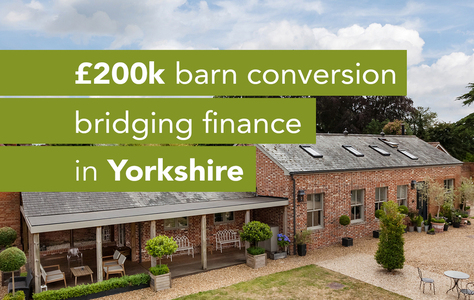
Urgent bridge finance for a quick completion on barn conversion in Yorkshire
Finance: £200,000Location: Yorkshire
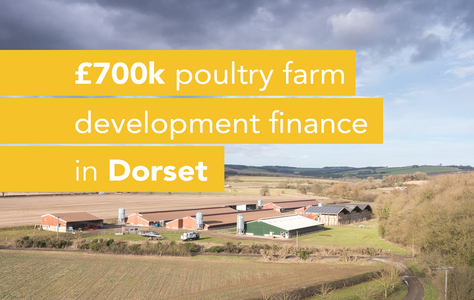
Farmer seeking urgent bridging finance for poultry farm development in Dorset
Finance: £700,000Location: Dorset

Bridging finance rescue for urgent payroll needs
Finance: £100,000Location: London
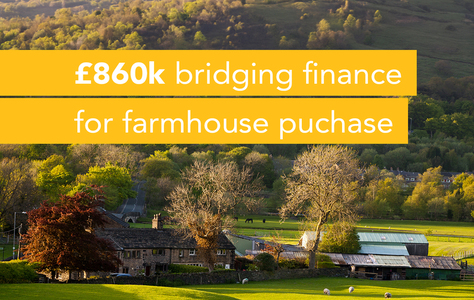
£860,000 bridge loan to complete farmhouse conversion project in Bath
Finance: £860,000Location: Bath, Somerset

Development finance secures land for 9 holiday homes
Finance: £650,000Location: Somerset
Renewable energy diversification
According to the NFU, 25% of UK farms plan on investing in renewable energy diversification by 2020. This could be wind turbines, solar PV farms or biomass boilers. A bridging loan can help farmers make this investment and diversify their operations.
Diversifying into related business
Farmers may require extra funds to invest in a new or related business which they believe will provide them with additional income. A bridging loan is the perfect solution for this purpose.
Equestrian diversification
Horse riding schools, equestrian centres and holiday accommodation are growing in demand across the UK. A bridging loan can provide farmers with the financial assistance to diversify their business into this sector.
Holiday parks
A bridging loan can be used for purchasing or extending a holiday park or expanding the business into the tourism sector diversifying the business and provide the farmer with an extra source of revenue.
Garden centres
Financing the purchase of a garden centre and the land around it is a common reason for taking out an agricultural bridging loan.
Working capital
Farmers typically require working capital for day-to-day activities such as paying wages or purchasing feeds and fertilisers. Bridge loans are a short-term financing solution so can be actioned quickly and are usually paid off within 2 years.
Property acquisitions
Purchasing additional property or finding an investment opportunity is another reason why farmers may need bridging finance. Investment opportunities tend to happen quickly and can be missed if financing delays the transaction. With agricultural finance they'll be able to purchase what they require without having to wait.
Generational transfers
Many farmers wish to pass down their farm and business to the next generation but require additional financing for this process. A bridging loan can help with that. The current owner can use the loan to purchase the property and/or equipment from his parents, who will then receive a lump sum.
Property renovation & refurbishment
Upgrading a farm building is a good opportunity for farmers to extend its life, improve efficiency, repurpose the building or enhance its appearance. Typically renovation and refurbishment is a more cost effective solution than demolition and building new.
Buying additional land
In order to expand a farm or diversify, farmers require additional space for the business. A bridging loan can help facilitate this.
Investing in equipment, plant & machinery
Farmers typically require financial assistance with purchasing new equipment that will help them improve the operation of their business and provide better yields.
Purchasing livestock
Many farmers are looking to increase their herd size, but they require additional financing in order for them to make the investment. A bridging loan can be used towards this purpose.
Why use an agricultural bridging loan?
Farmers need to invest in their future. This is especially true for those who are looking to grow their operation and start a new business venture. Agricultural bridging loans, also known as farm financing or agricultural finance, offer a variety of benefits that can provide the means for farmers to pursue an expansion project or purchase new equipment without having to sell assets. In this article, we will discuss 10 different ways agricultural bridging loans can be used by farmers and answer some frequently asked questions about these types of loans.
What are agricultural bridging loans?
An agricultural bridge loan is short-term financial assistance provided by banks and other lenders that enables farmers to invest in their business.
What can I use agricultural bridge loans for?
Examples of loan purposes range from purchasing livestock, equipment, plant, machinery, land, diversification, generational transfers, property renovations and refurbishment - almost anything.
Who is eligible for agricultural bridging finance?
Farm Finance is also open from both UK and International clients such as offshore borrowing vehicles from lenders. As long as your assets are in the UK our farmer finance is available to you.
How long does the application process take when applying for farm financing?
Typically loans up to £200k can be completed within 3 days and for loans up to £250m can take 14 - 30 days depending on their complexities.
What is the typical repayment term for agricultural bridging finance?
Typically, a loan will be repaid within 24 months depending on your individual needs. Loans can also be refinanced if you need additional time to repay funds due to unforeseen circumstances such as adverse weather conditions that affect crop yields or if your development is running behind schedule.
